Critique of Tesco's Strategy: Applying Models and Frameworks Analysis
VerifiedAdded on 2023/04/21
|20
|6234
|475
Report
AI Summary
This report provides a comprehensive analysis of Tesco's business-level strategy, utilizing various strategic models and frameworks. It begins with an overview of Tesco, including its mission, vision, financial position, and current market standing. The report then applies models such as SWOT, PESTLE, Porter’s Five Forces, VRIO, and Value Chain analysis to assess Tesco's internal and external environment, strategic capabilities, and competitive advantages. Corporate-level strategies are explored using the Ansoff Matrix and Bowman's Strategy Clock. The report concludes with recommendations for future strategy development, emphasizing suitability, acceptability, and feasibility (SAFE framework). This analysis aims to provide insights into Tesco's strategic approach and offer suggestions for enhancing its competitive position within the retail industry. This document is available on Desklib, a platform offering a wide range of study tools and solved assignments for students.
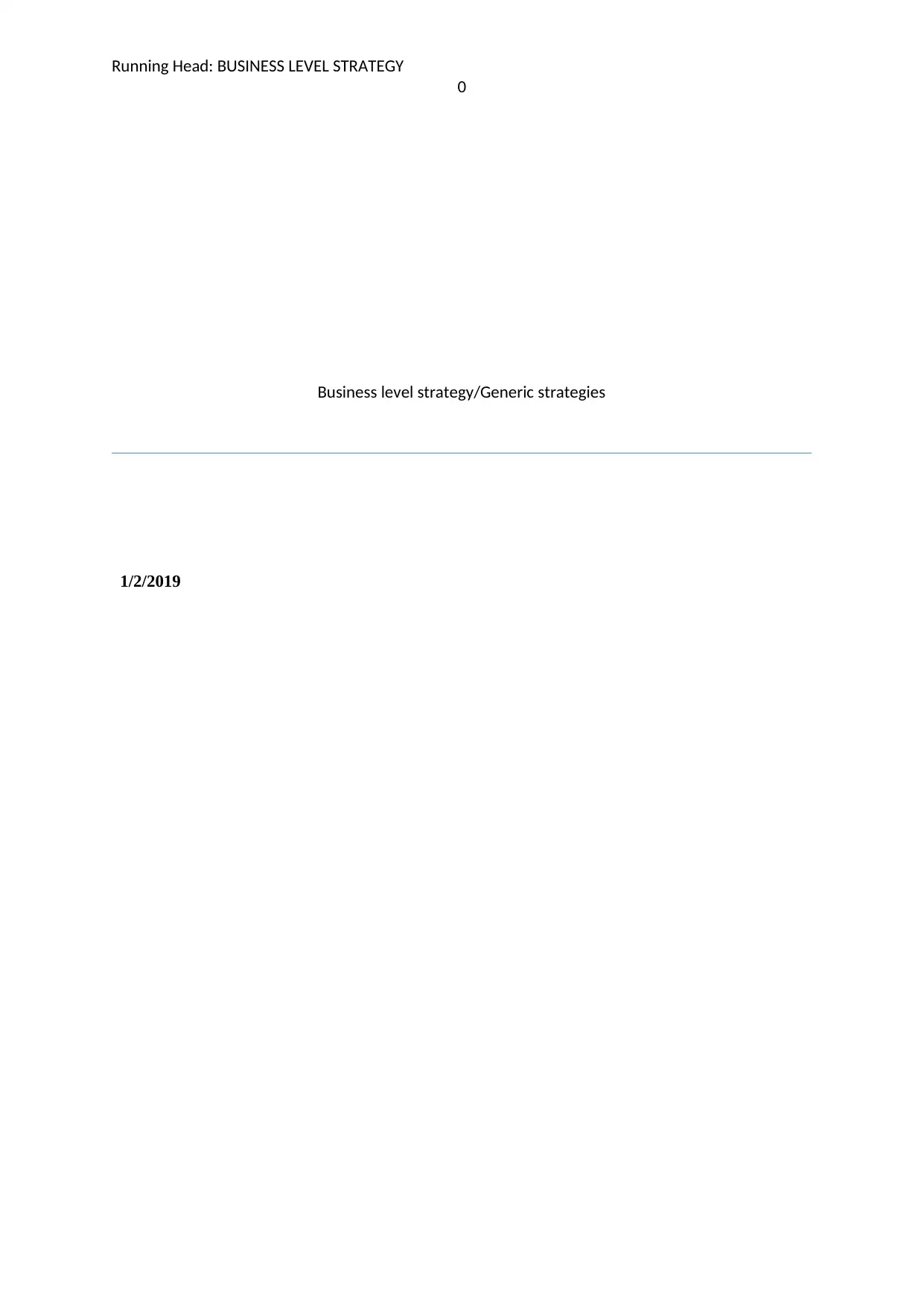
Running Head: BUSINESS LEVEL STRATEGY
0
Business level strategy/Generic strategies
1/2/2019
0
Business level strategy/Generic strategies
1/2/2019
Paraphrase This Document
Need a fresh take? Get an instant paraphrase of this document with our AI Paraphraser
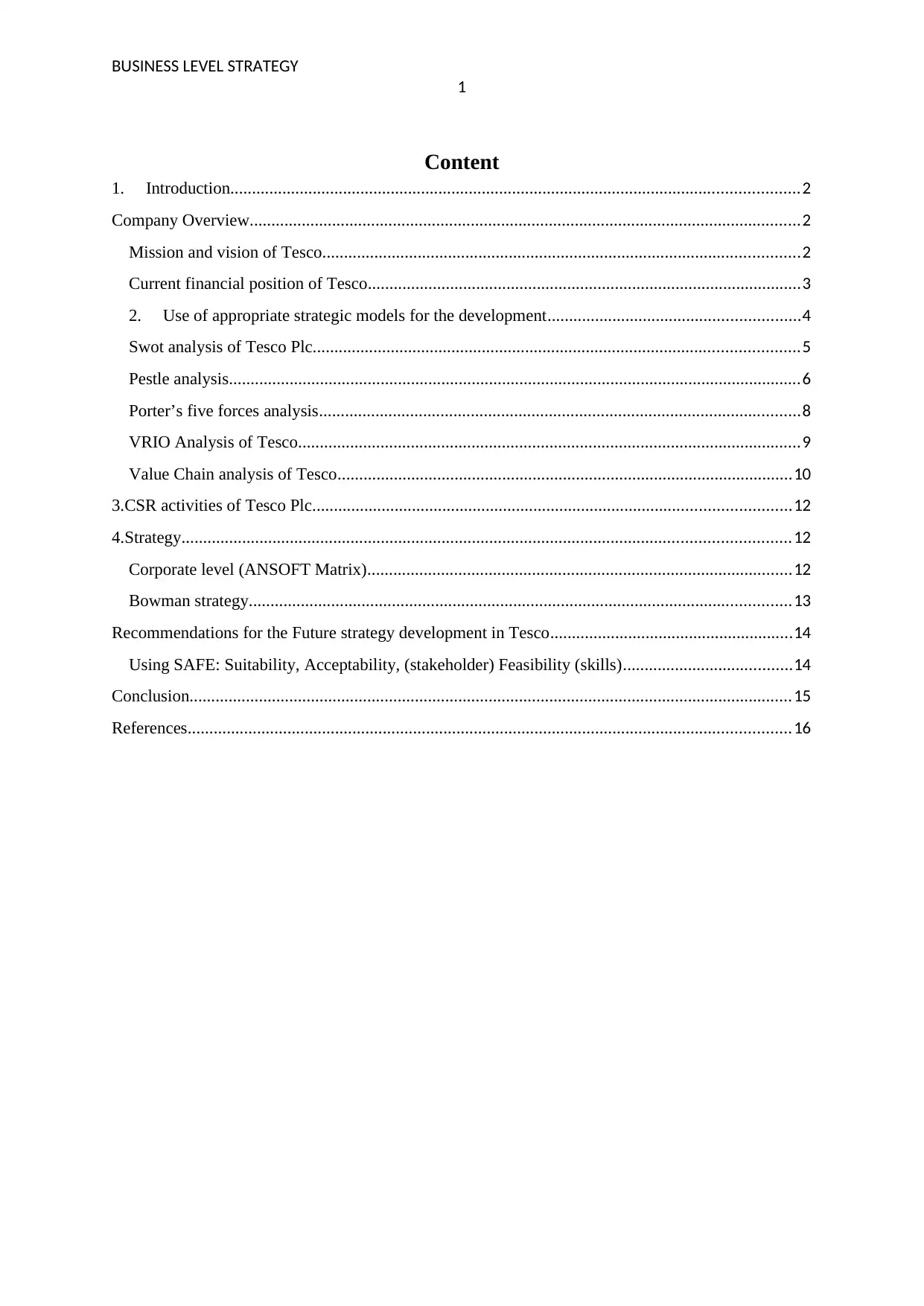
BUSINESS LEVEL STRATEGY
1
Content
1. Introduction...................................................................................................................................2
Company Overview...............................................................................................................................2
Mission and vision of Tesco..............................................................................................................2
Current financial position of Tesco....................................................................................................3
2. Use of appropriate strategic models for the development..........................................................4
Swot analysis of Tesco Plc................................................................................................................5
Pestle analysis....................................................................................................................................6
Porter’s five forces analysis...............................................................................................................8
VRIO Analysis of Tesco....................................................................................................................9
Value Chain analysis of Tesco.........................................................................................................10
3.CSR activities of Tesco Plc..............................................................................................................12
4.Strategy............................................................................................................................................12
Corporate level (ANSOFT Matrix)..................................................................................................12
Bowman strategy.............................................................................................................................13
Recommendations for the Future strategy development in Tesco........................................................14
Using SAFE: Suitability, Acceptability, (stakeholder) Feasibility (skills).......................................14
Conclusion...........................................................................................................................................15
References...........................................................................................................................................16
1
Content
1. Introduction...................................................................................................................................2
Company Overview...............................................................................................................................2
Mission and vision of Tesco..............................................................................................................2
Current financial position of Tesco....................................................................................................3
2. Use of appropriate strategic models for the development..........................................................4
Swot analysis of Tesco Plc................................................................................................................5
Pestle analysis....................................................................................................................................6
Porter’s five forces analysis...............................................................................................................8
VRIO Analysis of Tesco....................................................................................................................9
Value Chain analysis of Tesco.........................................................................................................10
3.CSR activities of Tesco Plc..............................................................................................................12
4.Strategy............................................................................................................................................12
Corporate level (ANSOFT Matrix)..................................................................................................12
Bowman strategy.............................................................................................................................13
Recommendations for the Future strategy development in Tesco........................................................14
Using SAFE: Suitability, Acceptability, (stakeholder) Feasibility (skills).......................................14
Conclusion...........................................................................................................................................15
References...........................................................................................................................................16
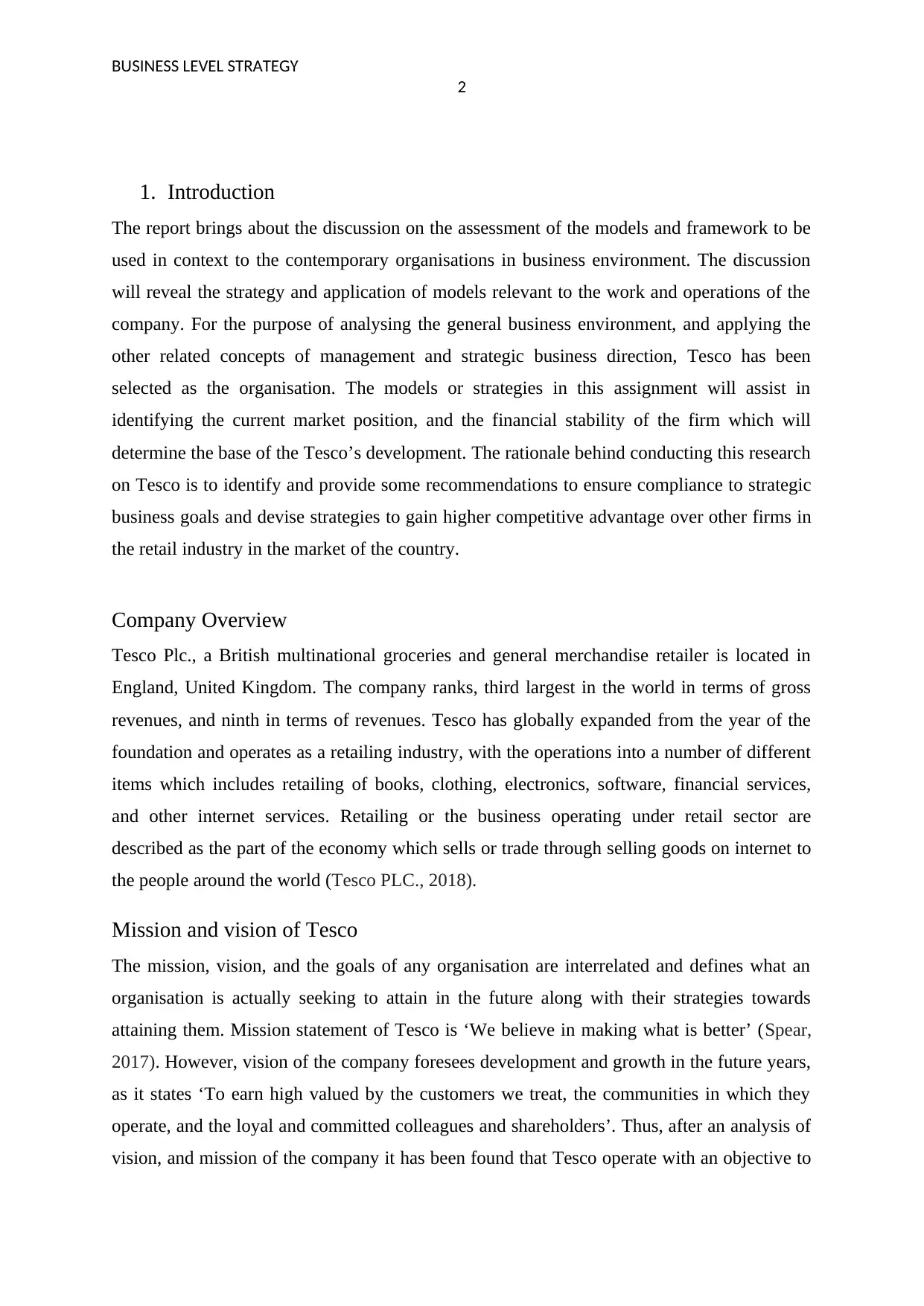
BUSINESS LEVEL STRATEGY
2
1. Introduction
The report brings about the discussion on the assessment of the models and framework to be
used in context to the contemporary organisations in business environment. The discussion
will reveal the strategy and application of models relevant to the work and operations of the
company. For the purpose of analysing the general business environment, and applying the
other related concepts of management and strategic business direction, Tesco has been
selected as the organisation. The models or strategies in this assignment will assist in
identifying the current market position, and the financial stability of the firm which will
determine the base of the Tesco’s development. The rationale behind conducting this research
on Tesco is to identify and provide some recommendations to ensure compliance to strategic
business goals and devise strategies to gain higher competitive advantage over other firms in
the retail industry in the market of the country.
Company Overview
Tesco Plc., a British multinational groceries and general merchandise retailer is located in
England, United Kingdom. The company ranks, third largest in the world in terms of gross
revenues, and ninth in terms of revenues. Tesco has globally expanded from the year of the
foundation and operates as a retailing industry, with the operations into a number of different
items which includes retailing of books, clothing, electronics, software, financial services,
and other internet services. Retailing or the business operating under retail sector are
described as the part of the economy which sells or trade through selling goods on internet to
the people around the world (Tesco PLC., 2018).
Mission and vision of Tesco
The mission, vision, and the goals of any organisation are interrelated and defines what an
organisation is actually seeking to attain in the future along with their strategies towards
attaining them. Mission statement of Tesco is ‘We believe in making what is better’ (Spear,
2017). However, vision of the company foresees development and growth in the future years,
as it states ‘To earn high valued by the customers we treat, the communities in which they
operate, and the loyal and committed colleagues and shareholders’. Thus, after an analysis of
vision, and mission of the company it has been found that Tesco operate with an objective to
2
1. Introduction
The report brings about the discussion on the assessment of the models and framework to be
used in context to the contemporary organisations in business environment. The discussion
will reveal the strategy and application of models relevant to the work and operations of the
company. For the purpose of analysing the general business environment, and applying the
other related concepts of management and strategic business direction, Tesco has been
selected as the organisation. The models or strategies in this assignment will assist in
identifying the current market position, and the financial stability of the firm which will
determine the base of the Tesco’s development. The rationale behind conducting this research
on Tesco is to identify and provide some recommendations to ensure compliance to strategic
business goals and devise strategies to gain higher competitive advantage over other firms in
the retail industry in the market of the country.
Company Overview
Tesco Plc., a British multinational groceries and general merchandise retailer is located in
England, United Kingdom. The company ranks, third largest in the world in terms of gross
revenues, and ninth in terms of revenues. Tesco has globally expanded from the year of the
foundation and operates as a retailing industry, with the operations into a number of different
items which includes retailing of books, clothing, electronics, software, financial services,
and other internet services. Retailing or the business operating under retail sector are
described as the part of the economy which sells or trade through selling goods on internet to
the people around the world (Tesco PLC., 2018).
Mission and vision of Tesco
The mission, vision, and the goals of any organisation are interrelated and defines what an
organisation is actually seeking to attain in the future along with their strategies towards
attaining them. Mission statement of Tesco is ‘We believe in making what is better’ (Spear,
2017). However, vision of the company foresees development and growth in the future years,
as it states ‘To earn high valued by the customers we treat, the communities in which they
operate, and the loyal and committed colleagues and shareholders’. Thus, after an analysis of
vision, and mission of the company it has been found that Tesco operate with an objective to
⊘ This is a preview!⊘
Do you want full access?
Subscribe today to unlock all pages.

Trusted by 1+ million students worldwide
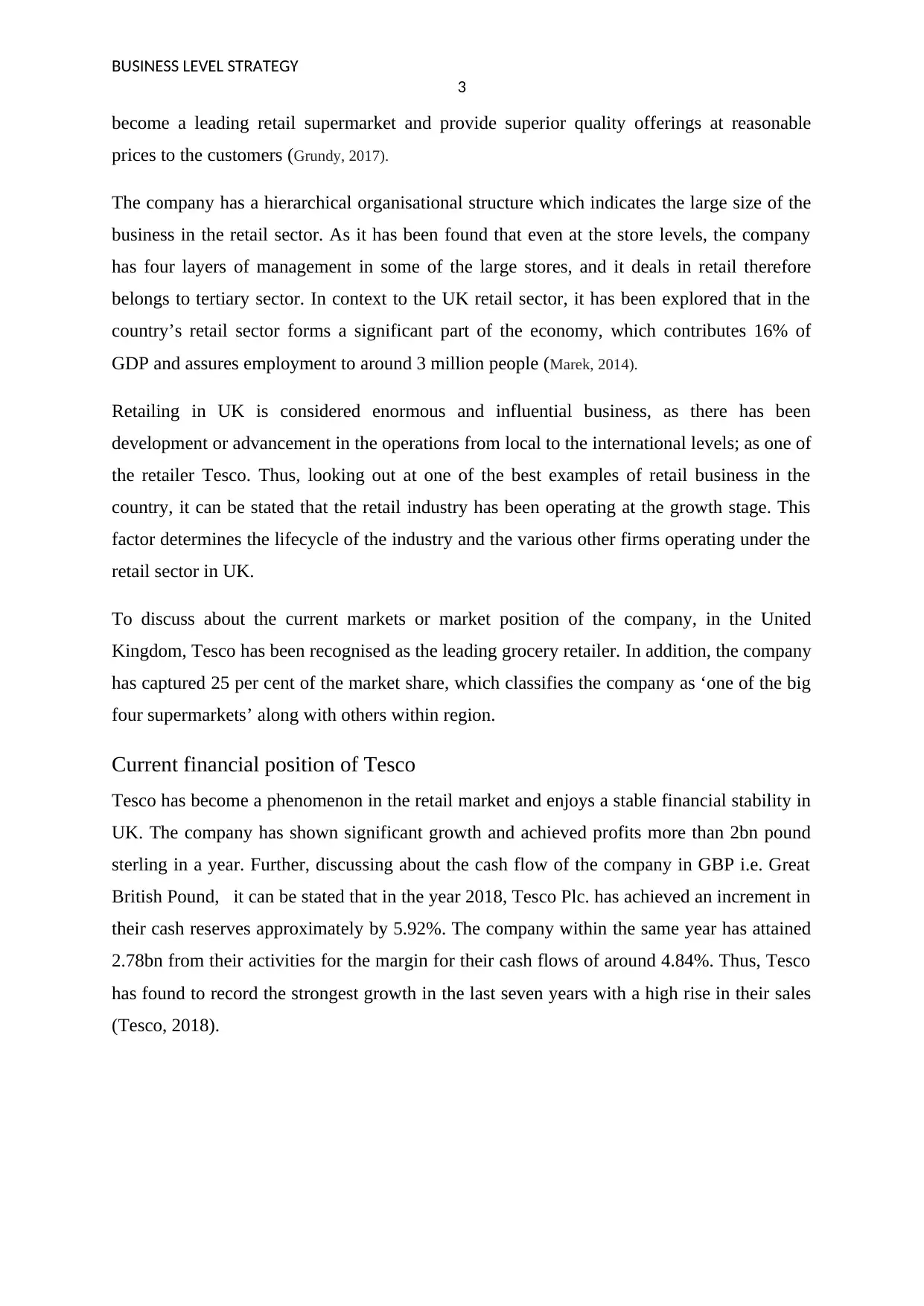
BUSINESS LEVEL STRATEGY
3
become a leading retail supermarket and provide superior quality offerings at reasonable
prices to the customers (Grundy, 2017).
The company has a hierarchical organisational structure which indicates the large size of the
business in the retail sector. As it has been found that even at the store levels, the company
has four layers of management in some of the large stores, and it deals in retail therefore
belongs to tertiary sector. In context to the UK retail sector, it has been explored that in the
country’s retail sector forms a significant part of the economy, which contributes 16% of
GDP and assures employment to around 3 million people (Marek, 2014).
Retailing in UK is considered enormous and influential business, as there has been
development or advancement in the operations from local to the international levels; as one of
the retailer Tesco. Thus, looking out at one of the best examples of retail business in the
country, it can be stated that the retail industry has been operating at the growth stage. This
factor determines the lifecycle of the industry and the various other firms operating under the
retail sector in UK.
To discuss about the current markets or market position of the company, in the United
Kingdom, Tesco has been recognised as the leading grocery retailer. In addition, the company
has captured 25 per cent of the market share, which classifies the company as ‘one of the big
four supermarkets’ along with others within region.
Current financial position of Tesco
Tesco has become a phenomenon in the retail market and enjoys a stable financial stability in
UK. The company has shown significant growth and achieved profits more than 2bn pound
sterling in a year. Further, discussing about the cash flow of the company in GBP i.e. Great
British Pound, it can be stated that in the year 2018, Tesco Plc. has achieved an increment in
their cash reserves approximately by 5.92%. The company within the same year has attained
2.78bn from their activities for the margin for their cash flows of around 4.84%. Thus, Tesco
has found to record the strongest growth in the last seven years with a high rise in their sales
(Tesco, 2018).
3
become a leading retail supermarket and provide superior quality offerings at reasonable
prices to the customers (Grundy, 2017).
The company has a hierarchical organisational structure which indicates the large size of the
business in the retail sector. As it has been found that even at the store levels, the company
has four layers of management in some of the large stores, and it deals in retail therefore
belongs to tertiary sector. In context to the UK retail sector, it has been explored that in the
country’s retail sector forms a significant part of the economy, which contributes 16% of
GDP and assures employment to around 3 million people (Marek, 2014).
Retailing in UK is considered enormous and influential business, as there has been
development or advancement in the operations from local to the international levels; as one of
the retailer Tesco. Thus, looking out at one of the best examples of retail business in the
country, it can be stated that the retail industry has been operating at the growth stage. This
factor determines the lifecycle of the industry and the various other firms operating under the
retail sector in UK.
To discuss about the current markets or market position of the company, in the United
Kingdom, Tesco has been recognised as the leading grocery retailer. In addition, the company
has captured 25 per cent of the market share, which classifies the company as ‘one of the big
four supermarkets’ along with others within region.
Current financial position of Tesco
Tesco has become a phenomenon in the retail market and enjoys a stable financial stability in
UK. The company has shown significant growth and achieved profits more than 2bn pound
sterling in a year. Further, discussing about the cash flow of the company in GBP i.e. Great
British Pound, it can be stated that in the year 2018, Tesco Plc. has achieved an increment in
their cash reserves approximately by 5.92%. The company within the same year has attained
2.78bn from their activities for the margin for their cash flows of around 4.84%. Thus, Tesco
has found to record the strongest growth in the last seven years with a high rise in their sales
(Tesco, 2018).
Paraphrase This Document
Need a fresh take? Get an instant paraphrase of this document with our AI Paraphraser
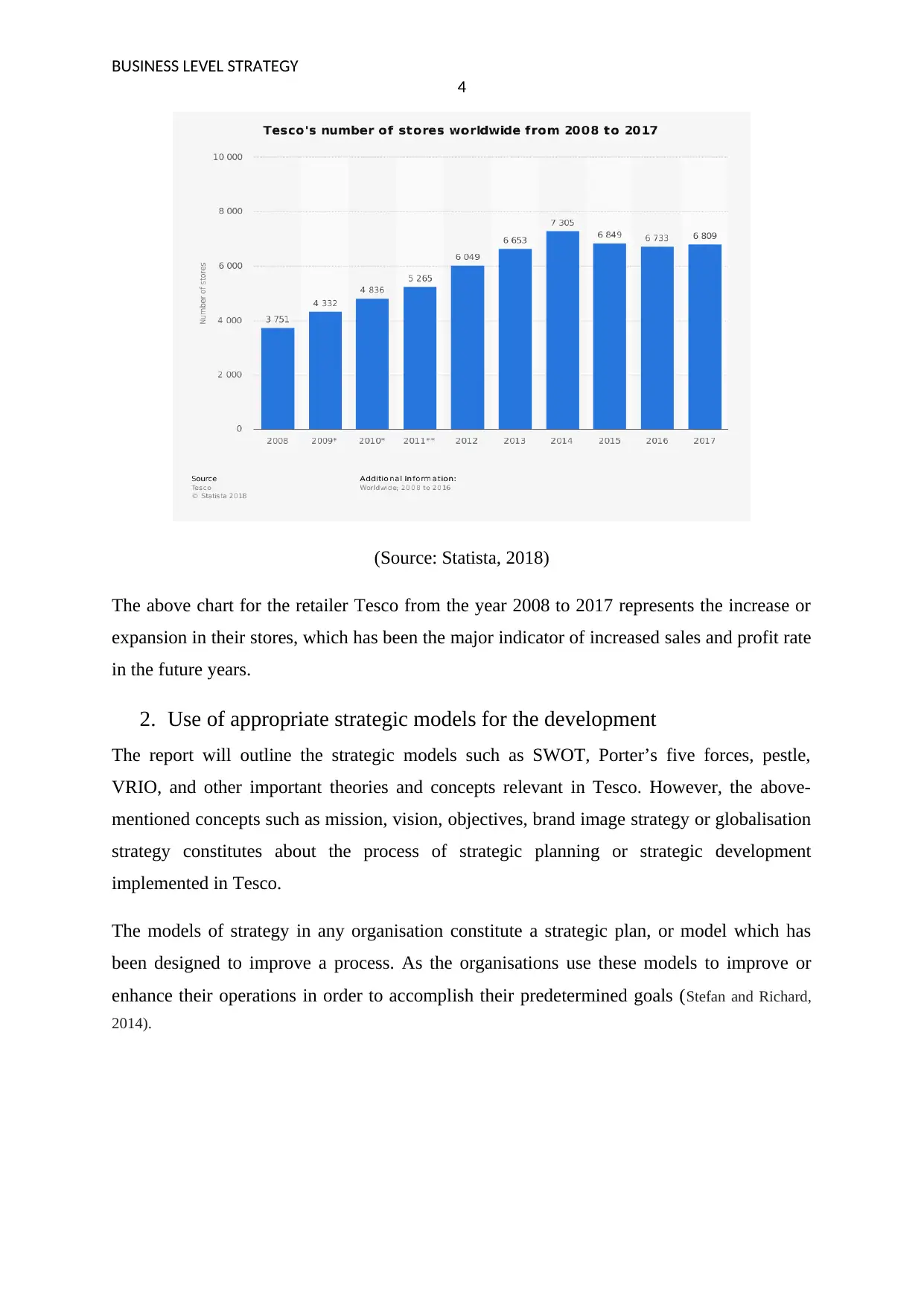
BUSINESS LEVEL STRATEGY
4
(Source: Statista, 2018)
The above chart for the retailer Tesco from the year 2008 to 2017 represents the increase or
expansion in their stores, which has been the major indicator of increased sales and profit rate
in the future years.
2. Use of appropriate strategic models for the development
The report will outline the strategic models such as SWOT, Porter’s five forces, pestle,
VRIO, and other important theories and concepts relevant in Tesco. However, the above-
mentioned concepts such as mission, vision, objectives, brand image strategy or globalisation
strategy constitutes about the process of strategic planning or strategic development
implemented in Tesco.
The models of strategy in any organisation constitute a strategic plan, or model which has
been designed to improve a process. As the organisations use these models to improve or
enhance their operations in order to accomplish their predetermined goals (Stefan and Richard,
2014).
4
(Source: Statista, 2018)
The above chart for the retailer Tesco from the year 2008 to 2017 represents the increase or
expansion in their stores, which has been the major indicator of increased sales and profit rate
in the future years.
2. Use of appropriate strategic models for the development
The report will outline the strategic models such as SWOT, Porter’s five forces, pestle,
VRIO, and other important theories and concepts relevant in Tesco. However, the above-
mentioned concepts such as mission, vision, objectives, brand image strategy or globalisation
strategy constitutes about the process of strategic planning or strategic development
implemented in Tesco.
The models of strategy in any organisation constitute a strategic plan, or model which has
been designed to improve a process. As the organisations use these models to improve or
enhance their operations in order to accomplish their predetermined goals (Stefan and Richard,
2014).
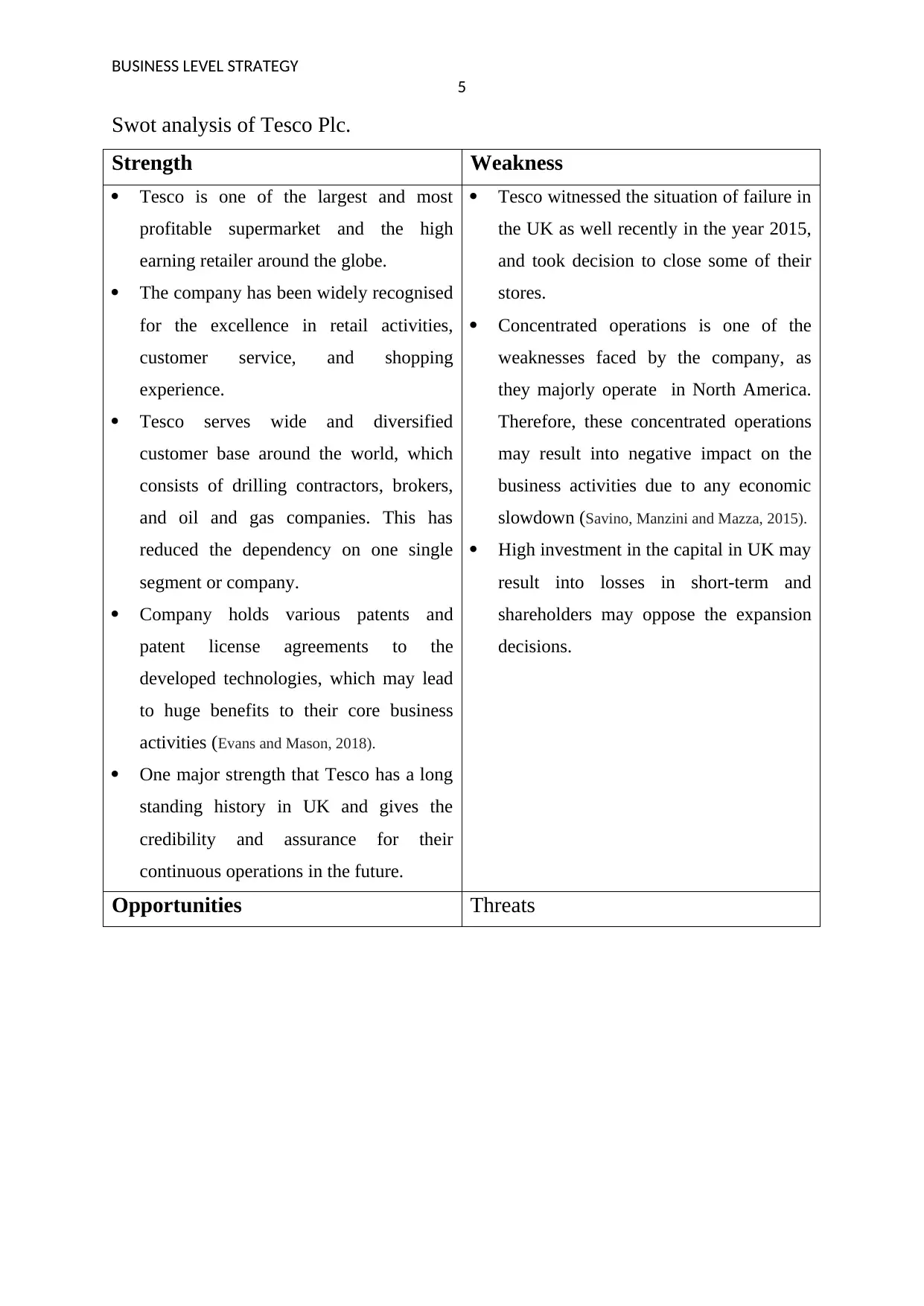
BUSINESS LEVEL STRATEGY
5
Swot analysis of Tesco Plc.
Strength Weakness
Tesco is one of the largest and most
profitable supermarket and the high
earning retailer around the globe.
The company has been widely recognised
for the excellence in retail activities,
customer service, and shopping
experience.
Tesco serves wide and diversified
customer base around the world, which
consists of drilling contractors, brokers,
and oil and gas companies. This has
reduced the dependency on one single
segment or company.
Company holds various patents and
patent license agreements to the
developed technologies, which may lead
to huge benefits to their core business
activities (Evans and Mason, 2018).
One major strength that Tesco has a long
standing history in UK and gives the
credibility and assurance for their
continuous operations in the future.
Tesco witnessed the situation of failure in
the UK as well recently in the year 2015,
and took decision to close some of their
stores.
Concentrated operations is one of the
weaknesses faced by the company, as
they majorly operate in North America.
Therefore, these concentrated operations
may result into negative impact on the
business activities due to any economic
slowdown (Savino, Manzini and Mazza, 2015).
High investment in the capital in UK may
result into losses in short-term and
shareholders may oppose the expansion
decisions.
Opportunities Threats
5
Swot analysis of Tesco Plc.
Strength Weakness
Tesco is one of the largest and most
profitable supermarket and the high
earning retailer around the globe.
The company has been widely recognised
for the excellence in retail activities,
customer service, and shopping
experience.
Tesco serves wide and diversified
customer base around the world, which
consists of drilling contractors, brokers,
and oil and gas companies. This has
reduced the dependency on one single
segment or company.
Company holds various patents and
patent license agreements to the
developed technologies, which may lead
to huge benefits to their core business
activities (Evans and Mason, 2018).
One major strength that Tesco has a long
standing history in UK and gives the
credibility and assurance for their
continuous operations in the future.
Tesco witnessed the situation of failure in
the UK as well recently in the year 2015,
and took decision to close some of their
stores.
Concentrated operations is one of the
weaknesses faced by the company, as
they majorly operate in North America.
Therefore, these concentrated operations
may result into negative impact on the
business activities due to any economic
slowdown (Savino, Manzini and Mazza, 2015).
High investment in the capital in UK may
result into losses in short-term and
shareholders may oppose the expansion
decisions.
Opportunities Threats
⊘ This is a preview!⊘
Do you want full access?
Subscribe today to unlock all pages.

Trusted by 1+ million students worldwide
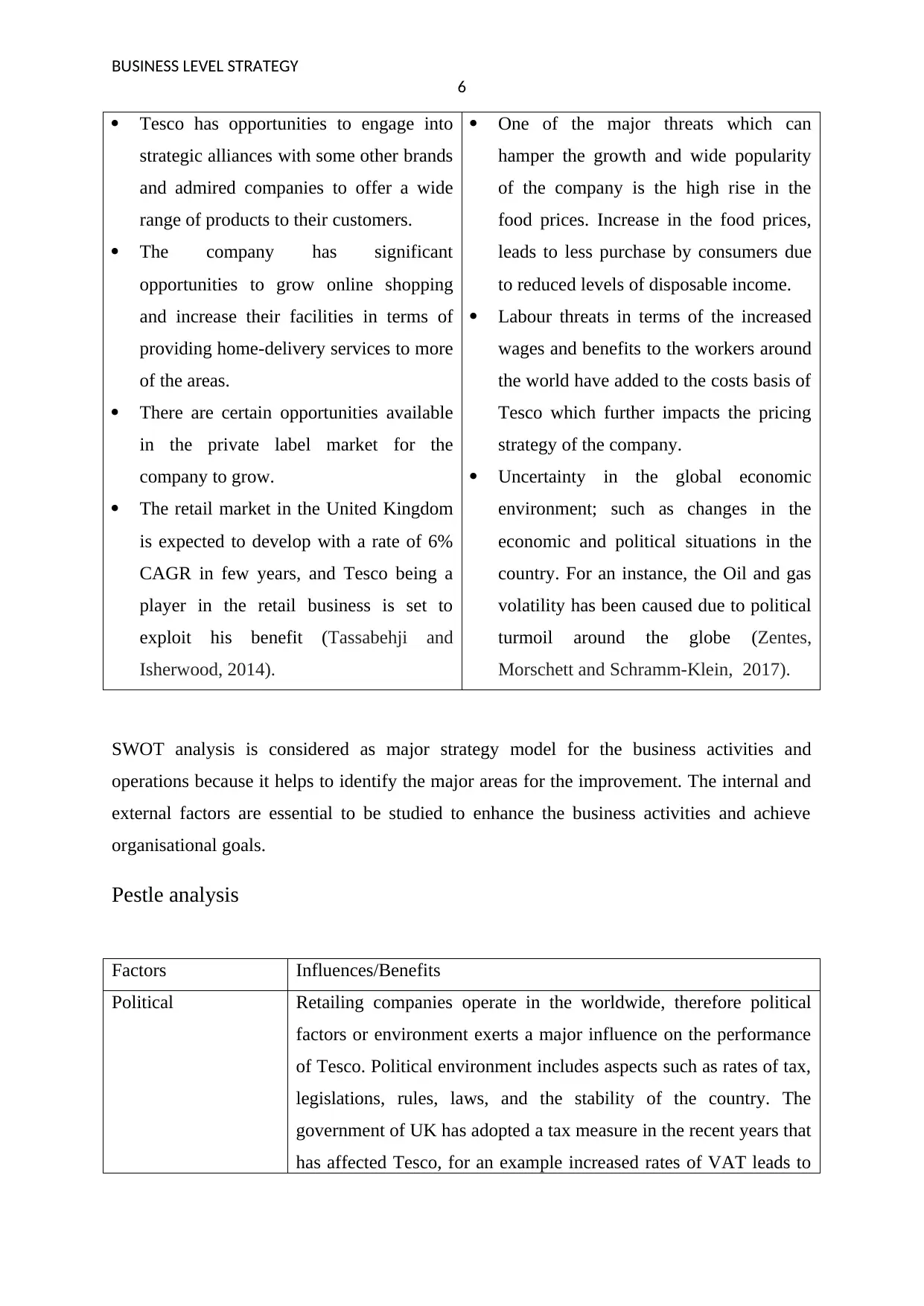
BUSINESS LEVEL STRATEGY
6
Tesco has opportunities to engage into
strategic alliances with some other brands
and admired companies to offer a wide
range of products to their customers.
The company has significant
opportunities to grow online shopping
and increase their facilities in terms of
providing home-delivery services to more
of the areas.
There are certain opportunities available
in the private label market for the
company to grow.
The retail market in the United Kingdom
is expected to develop with a rate of 6%
CAGR in few years, and Tesco being a
player in the retail business is set to
exploit his benefit (Tassabehji and
Isherwood, 2014).
One of the major threats which can
hamper the growth and wide popularity
of the company is the high rise in the
food prices. Increase in the food prices,
leads to less purchase by consumers due
to reduced levels of disposable income.
Labour threats in terms of the increased
wages and benefits to the workers around
the world have added to the costs basis of
Tesco which further impacts the pricing
strategy of the company.
Uncertainty in the global economic
environment; such as changes in the
economic and political situations in the
country. For an instance, the Oil and gas
volatility has been caused due to political
turmoil around the globe (Zentes,
Morschett and Schramm-Klein, 2017).
SWOT analysis is considered as major strategy model for the business activities and
operations because it helps to identify the major areas for the improvement. The internal and
external factors are essential to be studied to enhance the business activities and achieve
organisational goals.
Pestle analysis
Factors Influences/Benefits
Political Retailing companies operate in the worldwide, therefore political
factors or environment exerts a major influence on the performance
of Tesco. Political environment includes aspects such as rates of tax,
legislations, rules, laws, and the stability of the country. The
government of UK has adopted a tax measure in the recent years that
has affected Tesco, for an example increased rates of VAT leads to
6
Tesco has opportunities to engage into
strategic alliances with some other brands
and admired companies to offer a wide
range of products to their customers.
The company has significant
opportunities to grow online shopping
and increase their facilities in terms of
providing home-delivery services to more
of the areas.
There are certain opportunities available
in the private label market for the
company to grow.
The retail market in the United Kingdom
is expected to develop with a rate of 6%
CAGR in few years, and Tesco being a
player in the retail business is set to
exploit his benefit (Tassabehji and
Isherwood, 2014).
One of the major threats which can
hamper the growth and wide popularity
of the company is the high rise in the
food prices. Increase in the food prices,
leads to less purchase by consumers due
to reduced levels of disposable income.
Labour threats in terms of the increased
wages and benefits to the workers around
the world have added to the costs basis of
Tesco which further impacts the pricing
strategy of the company.
Uncertainty in the global economic
environment; such as changes in the
economic and political situations in the
country. For an instance, the Oil and gas
volatility has been caused due to political
turmoil around the globe (Zentes,
Morschett and Schramm-Klein, 2017).
SWOT analysis is considered as major strategy model for the business activities and
operations because it helps to identify the major areas for the improvement. The internal and
external factors are essential to be studied to enhance the business activities and achieve
organisational goals.
Pestle analysis
Factors Influences/Benefits
Political Retailing companies operate in the worldwide, therefore political
factors or environment exerts a major influence on the performance
of Tesco. Political environment includes aspects such as rates of tax,
legislations, rules, laws, and the stability of the country. The
government of UK has adopted a tax measure in the recent years that
has affected Tesco, for an example increased rates of VAT leads to
Paraphrase This Document
Need a fresh take? Get an instant paraphrase of this document with our AI Paraphraser
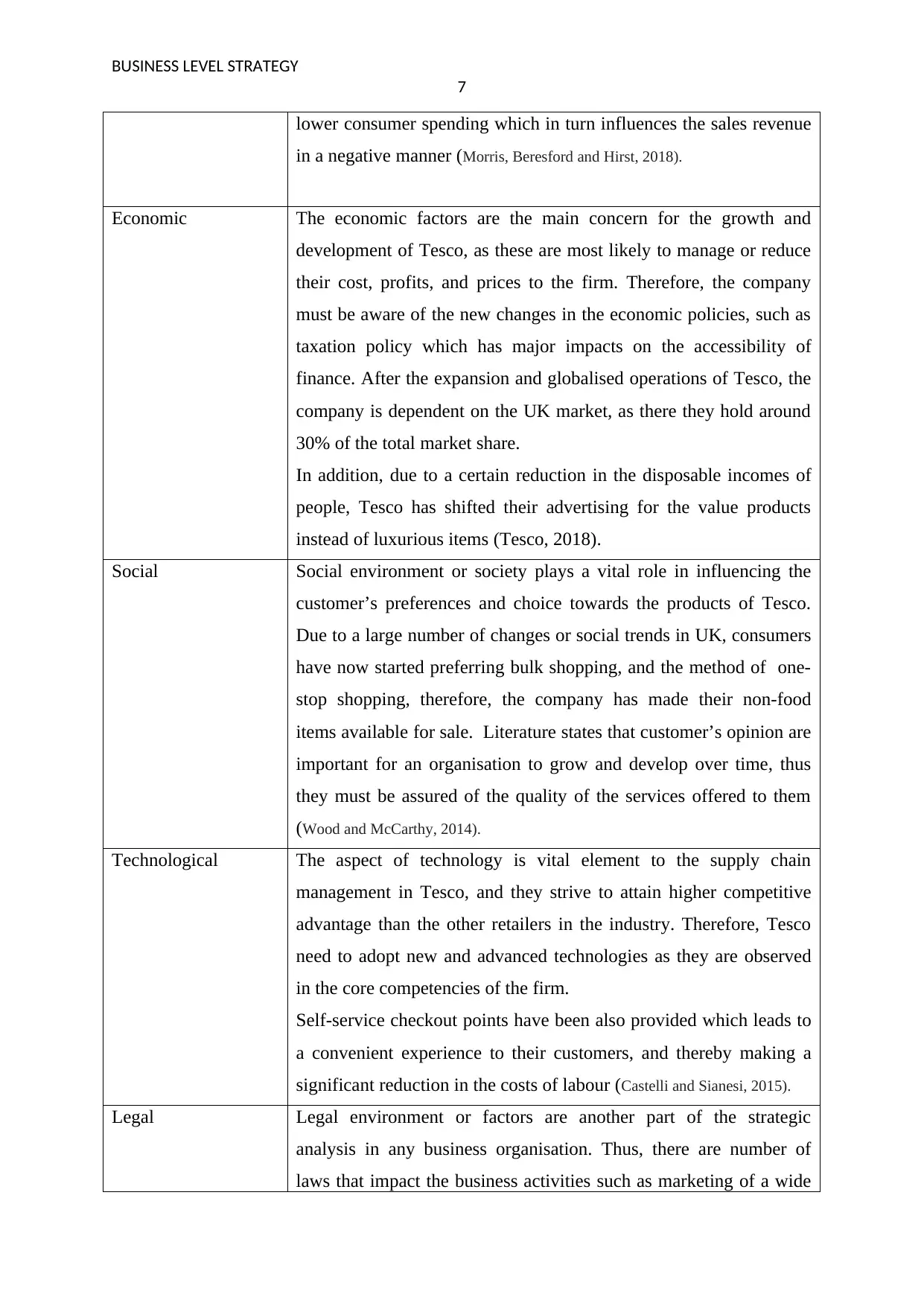
BUSINESS LEVEL STRATEGY
7
lower consumer spending which in turn influences the sales revenue
in a negative manner (Morris, Beresford and Hirst, 2018).
Economic The economic factors are the main concern for the growth and
development of Tesco, as these are most likely to manage or reduce
their cost, profits, and prices to the firm. Therefore, the company
must be aware of the new changes in the economic policies, such as
taxation policy which has major impacts on the accessibility of
finance. After the expansion and globalised operations of Tesco, the
company is dependent on the UK market, as there they hold around
30% of the total market share.
In addition, due to a certain reduction in the disposable incomes of
people, Tesco has shifted their advertising for the value products
instead of luxurious items (Tesco, 2018).
Social Social environment or society plays a vital role in influencing the
customer’s preferences and choice towards the products of Tesco.
Due to a large number of changes or social trends in UK, consumers
have now started preferring bulk shopping, and the method of one-
stop shopping, therefore, the company has made their non-food
items available for sale. Literature states that customer’s opinion are
important for an organisation to grow and develop over time, thus
they must be assured of the quality of the services offered to them
(Wood and McCarthy, 2014).
Technological The aspect of technology is vital element to the supply chain
management in Tesco, and they strive to attain higher competitive
advantage than the other retailers in the industry. Therefore, Tesco
need to adopt new and advanced technologies as they are observed
in the core competencies of the firm.
Self-service checkout points have been also provided which leads to
a convenient experience to their customers, and thereby making a
significant reduction in the costs of labour (Castelli and Sianesi, 2015).
Legal Legal environment or factors are another part of the strategic
analysis in any business organisation. Thus, there are number of
laws that impact the business activities such as marketing of a wide
7
lower consumer spending which in turn influences the sales revenue
in a negative manner (Morris, Beresford and Hirst, 2018).
Economic The economic factors are the main concern for the growth and
development of Tesco, as these are most likely to manage or reduce
their cost, profits, and prices to the firm. Therefore, the company
must be aware of the new changes in the economic policies, such as
taxation policy which has major impacts on the accessibility of
finance. After the expansion and globalised operations of Tesco, the
company is dependent on the UK market, as there they hold around
30% of the total market share.
In addition, due to a certain reduction in the disposable incomes of
people, Tesco has shifted their advertising for the value products
instead of luxurious items (Tesco, 2018).
Social Social environment or society plays a vital role in influencing the
customer’s preferences and choice towards the products of Tesco.
Due to a large number of changes or social trends in UK, consumers
have now started preferring bulk shopping, and the method of one-
stop shopping, therefore, the company has made their non-food
items available for sale. Literature states that customer’s opinion are
important for an organisation to grow and develop over time, thus
they must be assured of the quality of the services offered to them
(Wood and McCarthy, 2014).
Technological The aspect of technology is vital element to the supply chain
management in Tesco, and they strive to attain higher competitive
advantage than the other retailers in the industry. Therefore, Tesco
need to adopt new and advanced technologies as they are observed
in the core competencies of the firm.
Self-service checkout points have been also provided which leads to
a convenient experience to their customers, and thereby making a
significant reduction in the costs of labour (Castelli and Sianesi, 2015).
Legal Legal environment or factors are another part of the strategic
analysis in any business organisation. Thus, there are number of
laws that impact the business activities such as marketing of a wide
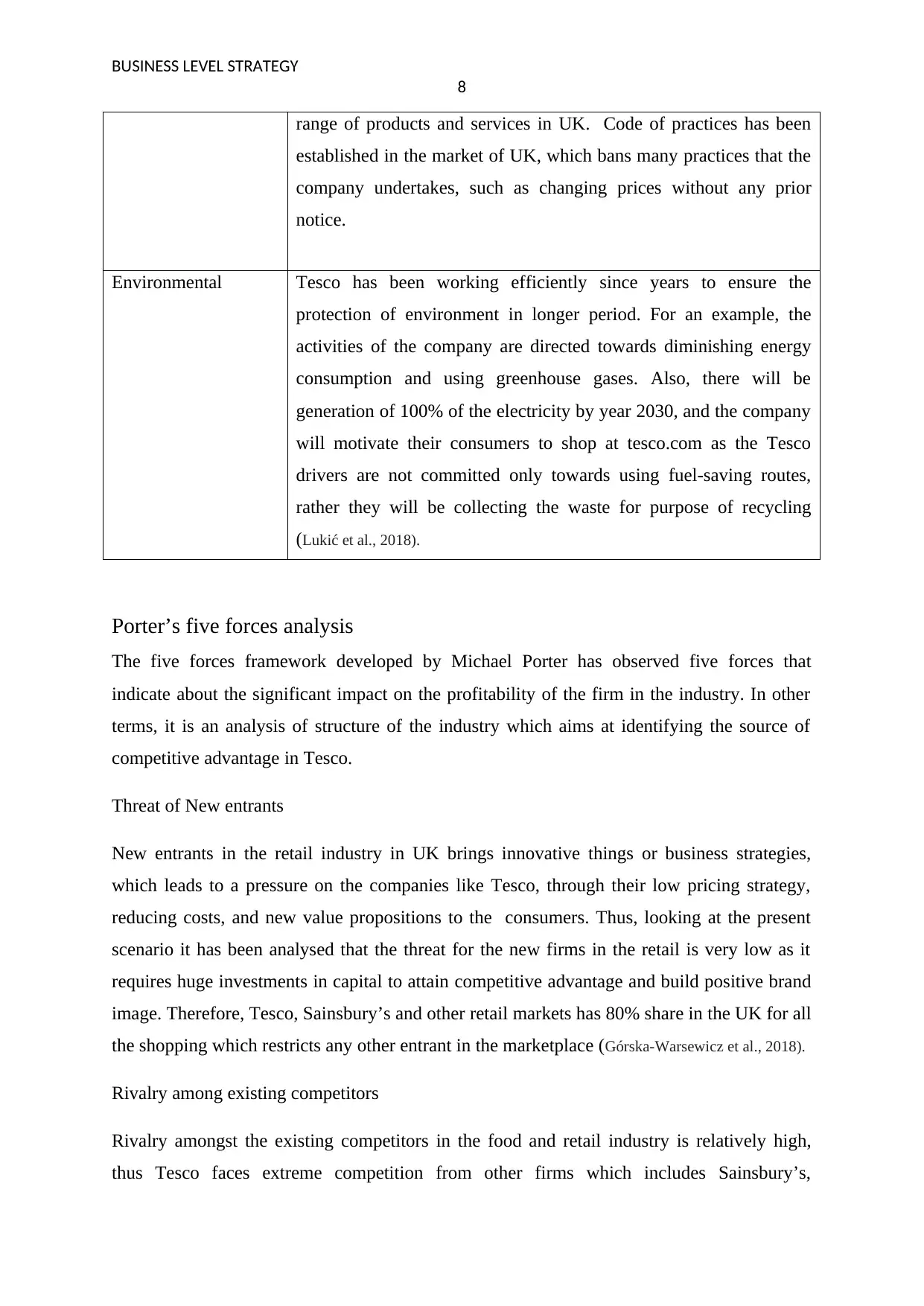
BUSINESS LEVEL STRATEGY
8
range of products and services in UK. Code of practices has been
established in the market of UK, which bans many practices that the
company undertakes, such as changing prices without any prior
notice.
Environmental Tesco has been working efficiently since years to ensure the
protection of environment in longer period. For an example, the
activities of the company are directed towards diminishing energy
consumption and using greenhouse gases. Also, there will be
generation of 100% of the electricity by year 2030, and the company
will motivate their consumers to shop at tesco.com as the Tesco
drivers are not committed only towards using fuel-saving routes,
rather they will be collecting the waste for purpose of recycling
(Lukić et al., 2018).
Porter’s five forces analysis
The five forces framework developed by Michael Porter has observed five forces that
indicate about the significant impact on the profitability of the firm in the industry. In other
terms, it is an analysis of structure of the industry which aims at identifying the source of
competitive advantage in Tesco.
Threat of New entrants
New entrants in the retail industry in UK brings innovative things or business strategies,
which leads to a pressure on the companies like Tesco, through their low pricing strategy,
reducing costs, and new value propositions to the consumers. Thus, looking at the present
scenario it has been analysed that the threat for the new firms in the retail is very low as it
requires huge investments in capital to attain competitive advantage and build positive brand
image. Therefore, Tesco, Sainsbury’s and other retail markets has 80% share in the UK for all
the shopping which restricts any other entrant in the marketplace (Górska-Warsewicz et al., 2018).
Rivalry among existing competitors
Rivalry amongst the existing competitors in the food and retail industry is relatively high,
thus Tesco faces extreme competition from other firms which includes Sainsbury’s,
8
range of products and services in UK. Code of practices has been
established in the market of UK, which bans many practices that the
company undertakes, such as changing prices without any prior
notice.
Environmental Tesco has been working efficiently since years to ensure the
protection of environment in longer period. For an example, the
activities of the company are directed towards diminishing energy
consumption and using greenhouse gases. Also, there will be
generation of 100% of the electricity by year 2030, and the company
will motivate their consumers to shop at tesco.com as the Tesco
drivers are not committed only towards using fuel-saving routes,
rather they will be collecting the waste for purpose of recycling
(Lukić et al., 2018).
Porter’s five forces analysis
The five forces framework developed by Michael Porter has observed five forces that
indicate about the significant impact on the profitability of the firm in the industry. In other
terms, it is an analysis of structure of the industry which aims at identifying the source of
competitive advantage in Tesco.
Threat of New entrants
New entrants in the retail industry in UK brings innovative things or business strategies,
which leads to a pressure on the companies like Tesco, through their low pricing strategy,
reducing costs, and new value propositions to the consumers. Thus, looking at the present
scenario it has been analysed that the threat for the new firms in the retail is very low as it
requires huge investments in capital to attain competitive advantage and build positive brand
image. Therefore, Tesco, Sainsbury’s and other retail markets has 80% share in the UK for all
the shopping which restricts any other entrant in the marketplace (Górska-Warsewicz et al., 2018).
Rivalry among existing competitors
Rivalry amongst the existing competitors in the food and retail industry is relatively high,
thus Tesco faces extreme competition from other firms which includes Sainsbury’s,
⊘ This is a preview!⊘
Do you want full access?
Subscribe today to unlock all pages.

Trusted by 1+ million students worldwide
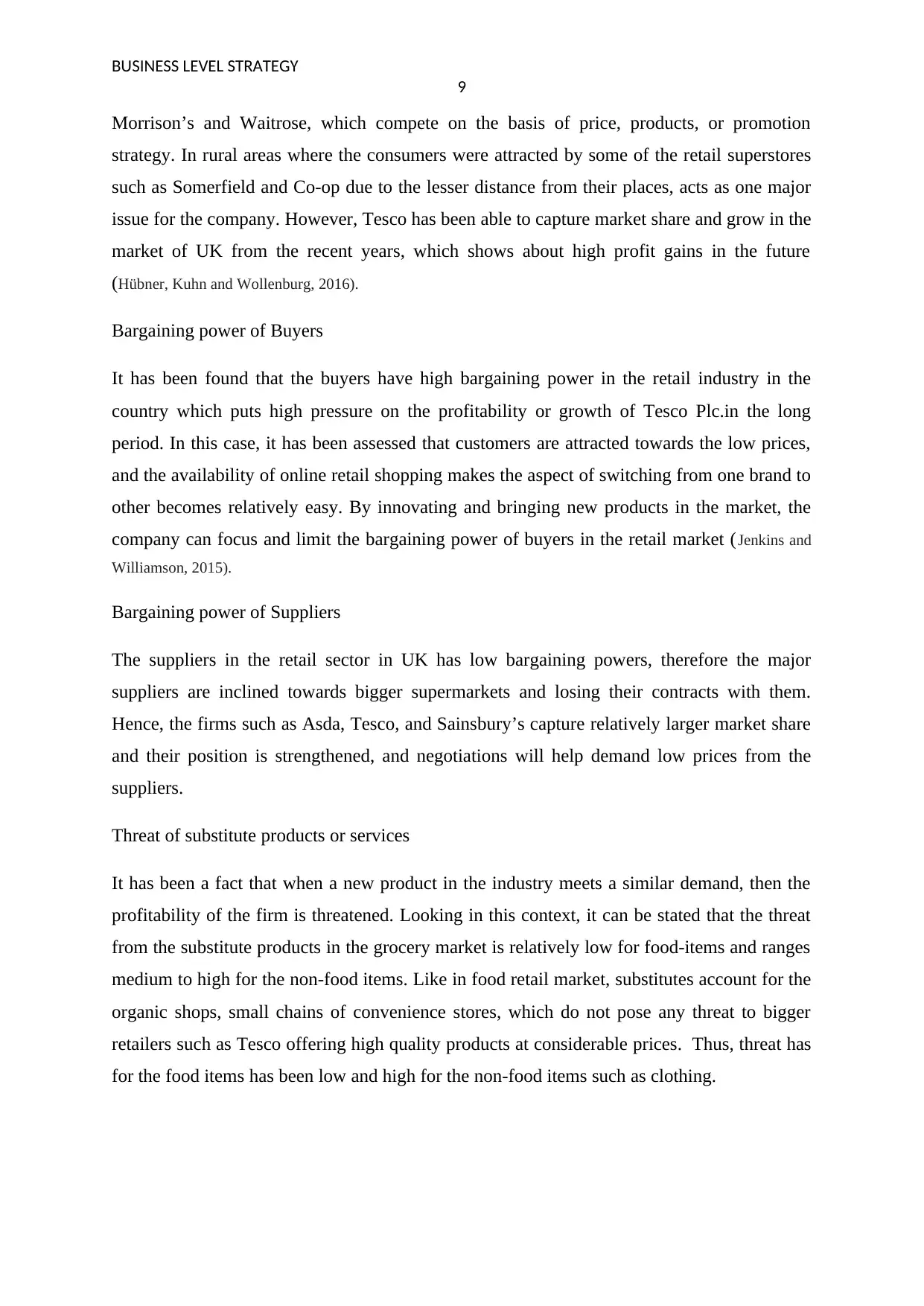
BUSINESS LEVEL STRATEGY
9
Morrison’s and Waitrose, which compete on the basis of price, products, or promotion
strategy. In rural areas where the consumers were attracted by some of the retail superstores
such as Somerfield and Co-op due to the lesser distance from their places, acts as one major
issue for the company. However, Tesco has been able to capture market share and grow in the
market of UK from the recent years, which shows about high profit gains in the future
(Hübner, Kuhn and Wollenburg, 2016).
Bargaining power of Buyers
It has been found that the buyers have high bargaining power in the retail industry in the
country which puts high pressure on the profitability or growth of Tesco Plc.in the long
period. In this case, it has been assessed that customers are attracted towards the low prices,
and the availability of online retail shopping makes the aspect of switching from one brand to
other becomes relatively easy. By innovating and bringing new products in the market, the
company can focus and limit the bargaining power of buyers in the retail market (Jenkins and
Williamson, 2015).
Bargaining power of Suppliers
The suppliers in the retail sector in UK has low bargaining powers, therefore the major
suppliers are inclined towards bigger supermarkets and losing their contracts with them.
Hence, the firms such as Asda, Tesco, and Sainsbury’s capture relatively larger market share
and their position is strengthened, and negotiations will help demand low prices from the
suppliers.
Threat of substitute products or services
It has been a fact that when a new product in the industry meets a similar demand, then the
profitability of the firm is threatened. Looking in this context, it can be stated that the threat
from the substitute products in the grocery market is relatively low for food-items and ranges
medium to high for the non-food items. Like in food retail market, substitutes account for the
organic shops, small chains of convenience stores, which do not pose any threat to bigger
retailers such as Tesco offering high quality products at considerable prices. Thus, threat has
for the food items has been low and high for the non-food items such as clothing.
9
Morrison’s and Waitrose, which compete on the basis of price, products, or promotion
strategy. In rural areas where the consumers were attracted by some of the retail superstores
such as Somerfield and Co-op due to the lesser distance from their places, acts as one major
issue for the company. However, Tesco has been able to capture market share and grow in the
market of UK from the recent years, which shows about high profit gains in the future
(Hübner, Kuhn and Wollenburg, 2016).
Bargaining power of Buyers
It has been found that the buyers have high bargaining power in the retail industry in the
country which puts high pressure on the profitability or growth of Tesco Plc.in the long
period. In this case, it has been assessed that customers are attracted towards the low prices,
and the availability of online retail shopping makes the aspect of switching from one brand to
other becomes relatively easy. By innovating and bringing new products in the market, the
company can focus and limit the bargaining power of buyers in the retail market (Jenkins and
Williamson, 2015).
Bargaining power of Suppliers
The suppliers in the retail sector in UK has low bargaining powers, therefore the major
suppliers are inclined towards bigger supermarkets and losing their contracts with them.
Hence, the firms such as Asda, Tesco, and Sainsbury’s capture relatively larger market share
and their position is strengthened, and negotiations will help demand low prices from the
suppliers.
Threat of substitute products or services
It has been a fact that when a new product in the industry meets a similar demand, then the
profitability of the firm is threatened. Looking in this context, it can be stated that the threat
from the substitute products in the grocery market is relatively low for food-items and ranges
medium to high for the non-food items. Like in food retail market, substitutes account for the
organic shops, small chains of convenience stores, which do not pose any threat to bigger
retailers such as Tesco offering high quality products at considerable prices. Thus, threat has
for the food items has been low and high for the non-food items such as clothing.
Paraphrase This Document
Need a fresh take? Get an instant paraphrase of this document with our AI Paraphraser
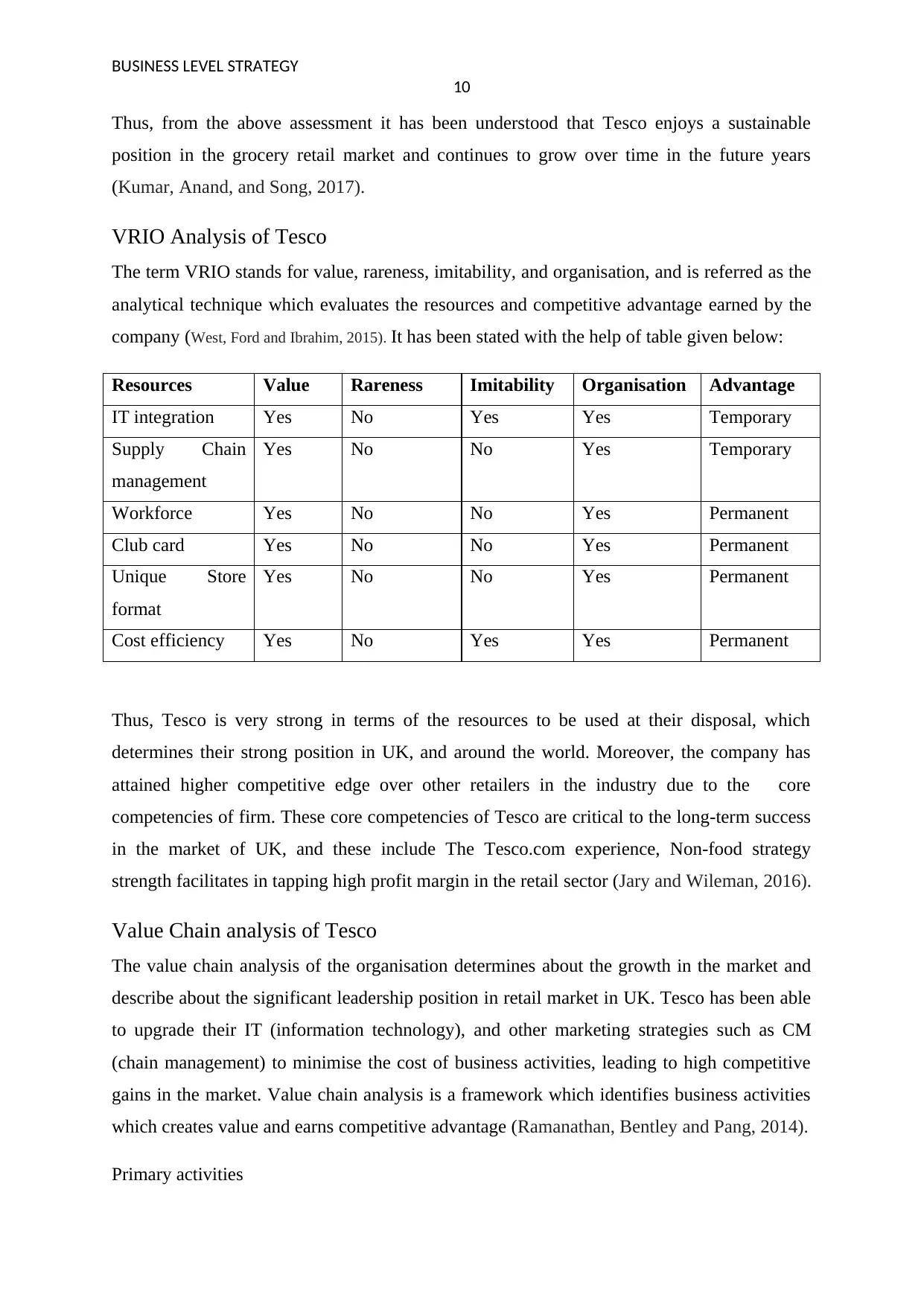
BUSINESS LEVEL STRATEGY
10
Thus, from the above assessment it has been understood that Tesco enjoys a sustainable
position in the grocery retail market and continues to grow over time in the future years
(Kumar, Anand, and Song, 2017).
VRIO Analysis of Tesco
The term VRIO stands for value, rareness, imitability, and organisation, and is referred as the
analytical technique which evaluates the resources and competitive advantage earned by the
company (West, Ford and Ibrahim, 2015). It has been stated with the help of table given below:
Resources Value Rareness Imitability Organisation Advantage
IT integration Yes No Yes Yes Temporary
Supply Chain
management
Yes No No Yes Temporary
Workforce Yes No No Yes Permanent
Club card Yes No No Yes Permanent
Unique Store
format
Yes No No Yes Permanent
Cost efficiency Yes No Yes Yes Permanent
Thus, Tesco is very strong in terms of the resources to be used at their disposal, which
determines their strong position in UK, and around the world. Moreover, the company has
attained higher competitive edge over other retailers in the industry due to the core
competencies of firm. These core competencies of Tesco are critical to the long-term success
in the market of UK, and these include The Tesco.com experience, Non-food strategy
strength facilitates in tapping high profit margin in the retail sector (Jary and Wileman, 2016).
Value Chain analysis of Tesco
The value chain analysis of the organisation determines about the growth in the market and
describe about the significant leadership position in retail market in UK. Tesco has been able
to upgrade their IT (information technology), and other marketing strategies such as CM
(chain management) to minimise the cost of business activities, leading to high competitive
gains in the market. Value chain analysis is a framework which identifies business activities
which creates value and earns competitive advantage (Ramanathan, Bentley and Pang, 2014).
Primary activities
10
Thus, from the above assessment it has been understood that Tesco enjoys a sustainable
position in the grocery retail market and continues to grow over time in the future years
(Kumar, Anand, and Song, 2017).
VRIO Analysis of Tesco
The term VRIO stands for value, rareness, imitability, and organisation, and is referred as the
analytical technique which evaluates the resources and competitive advantage earned by the
company (West, Ford and Ibrahim, 2015). It has been stated with the help of table given below:
Resources Value Rareness Imitability Organisation Advantage
IT integration Yes No Yes Yes Temporary
Supply Chain
management
Yes No No Yes Temporary
Workforce Yes No No Yes Permanent
Club card Yes No No Yes Permanent
Unique Store
format
Yes No No Yes Permanent
Cost efficiency Yes No Yes Yes Permanent
Thus, Tesco is very strong in terms of the resources to be used at their disposal, which
determines their strong position in UK, and around the world. Moreover, the company has
attained higher competitive edge over other retailers in the industry due to the core
competencies of firm. These core competencies of Tesco are critical to the long-term success
in the market of UK, and these include The Tesco.com experience, Non-food strategy
strength facilitates in tapping high profit margin in the retail sector (Jary and Wileman, 2016).
Value Chain analysis of Tesco
The value chain analysis of the organisation determines about the growth in the market and
describe about the significant leadership position in retail market in UK. Tesco has been able
to upgrade their IT (information technology), and other marketing strategies such as CM
(chain management) to minimise the cost of business activities, leading to high competitive
gains in the market. Value chain analysis is a framework which identifies business activities
which creates value and earns competitive advantage (Ramanathan, Bentley and Pang, 2014).
Primary activities
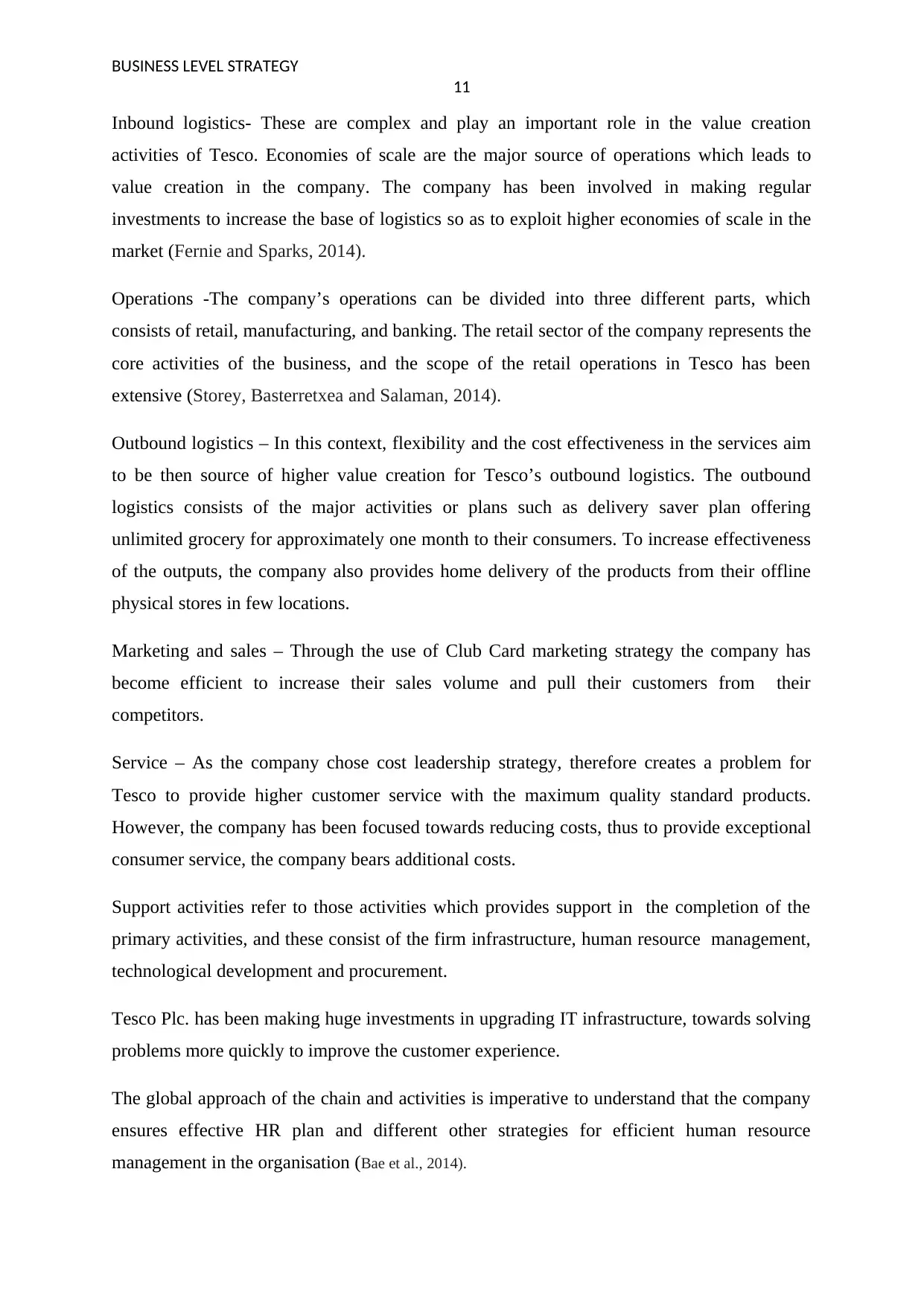
BUSINESS LEVEL STRATEGY
11
Inbound logistics- These are complex and play an important role in the value creation
activities of Tesco. Economies of scale are the major source of operations which leads to
value creation in the company. The company has been involved in making regular
investments to increase the base of logistics so as to exploit higher economies of scale in the
market (Fernie and Sparks, 2014).
Operations -The company’s operations can be divided into three different parts, which
consists of retail, manufacturing, and banking. The retail sector of the company represents the
core activities of the business, and the scope of the retail operations in Tesco has been
extensive (Storey, Basterretxea and Salaman, 2014).
Outbound logistics – In this context, flexibility and the cost effectiveness in the services aim
to be then source of higher value creation for Tesco’s outbound logistics. The outbound
logistics consists of the major activities or plans such as delivery saver plan offering
unlimited grocery for approximately one month to their consumers. To increase effectiveness
of the outputs, the company also provides home delivery of the products from their offline
physical stores in few locations.
Marketing and sales – Through the use of Club Card marketing strategy the company has
become efficient to increase their sales volume and pull their customers from their
competitors.
Service – As the company chose cost leadership strategy, therefore creates a problem for
Tesco to provide higher customer service with the maximum quality standard products.
However, the company has been focused towards reducing costs, thus to provide exceptional
consumer service, the company bears additional costs.
Support activities refer to those activities which provides support in the completion of the
primary activities, and these consist of the firm infrastructure, human resource management,
technological development and procurement.
Tesco Plc. has been making huge investments in upgrading IT infrastructure, towards solving
problems more quickly to improve the customer experience.
The global approach of the chain and activities is imperative to understand that the company
ensures effective HR plan and different other strategies for efficient human resource
management in the organisation (Bae et al., 2014).
11
Inbound logistics- These are complex and play an important role in the value creation
activities of Tesco. Economies of scale are the major source of operations which leads to
value creation in the company. The company has been involved in making regular
investments to increase the base of logistics so as to exploit higher economies of scale in the
market (Fernie and Sparks, 2014).
Operations -The company’s operations can be divided into three different parts, which
consists of retail, manufacturing, and banking. The retail sector of the company represents the
core activities of the business, and the scope of the retail operations in Tesco has been
extensive (Storey, Basterretxea and Salaman, 2014).
Outbound logistics – In this context, flexibility and the cost effectiveness in the services aim
to be then source of higher value creation for Tesco’s outbound logistics. The outbound
logistics consists of the major activities or plans such as delivery saver plan offering
unlimited grocery for approximately one month to their consumers. To increase effectiveness
of the outputs, the company also provides home delivery of the products from their offline
physical stores in few locations.
Marketing and sales – Through the use of Club Card marketing strategy the company has
become efficient to increase their sales volume and pull their customers from their
competitors.
Service – As the company chose cost leadership strategy, therefore creates a problem for
Tesco to provide higher customer service with the maximum quality standard products.
However, the company has been focused towards reducing costs, thus to provide exceptional
consumer service, the company bears additional costs.
Support activities refer to those activities which provides support in the completion of the
primary activities, and these consist of the firm infrastructure, human resource management,
technological development and procurement.
Tesco Plc. has been making huge investments in upgrading IT infrastructure, towards solving
problems more quickly to improve the customer experience.
The global approach of the chain and activities is imperative to understand that the company
ensures effective HR plan and different other strategies for efficient human resource
management in the organisation (Bae et al., 2014).
⊘ This is a preview!⊘
Do you want full access?
Subscribe today to unlock all pages.

Trusted by 1+ million students worldwide
1 out of 20
Related Documents
Your All-in-One AI-Powered Toolkit for Academic Success.
+13062052269
info@desklib.com
Available 24*7 on WhatsApp / Email
![[object Object]](/_next/static/media/star-bottom.7253800d.svg)
Unlock your academic potential
Copyright © 2020–2025 A2Z Services. All Rights Reserved. Developed and managed by ZUCOL.




